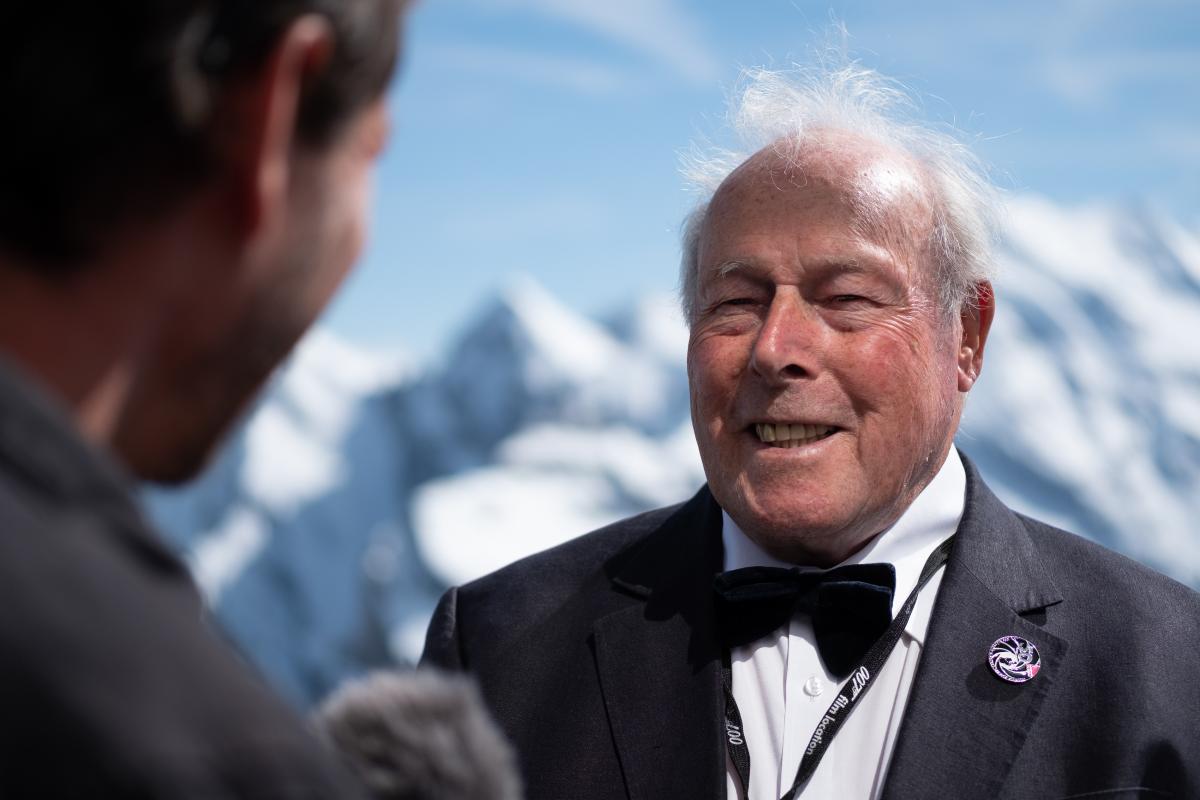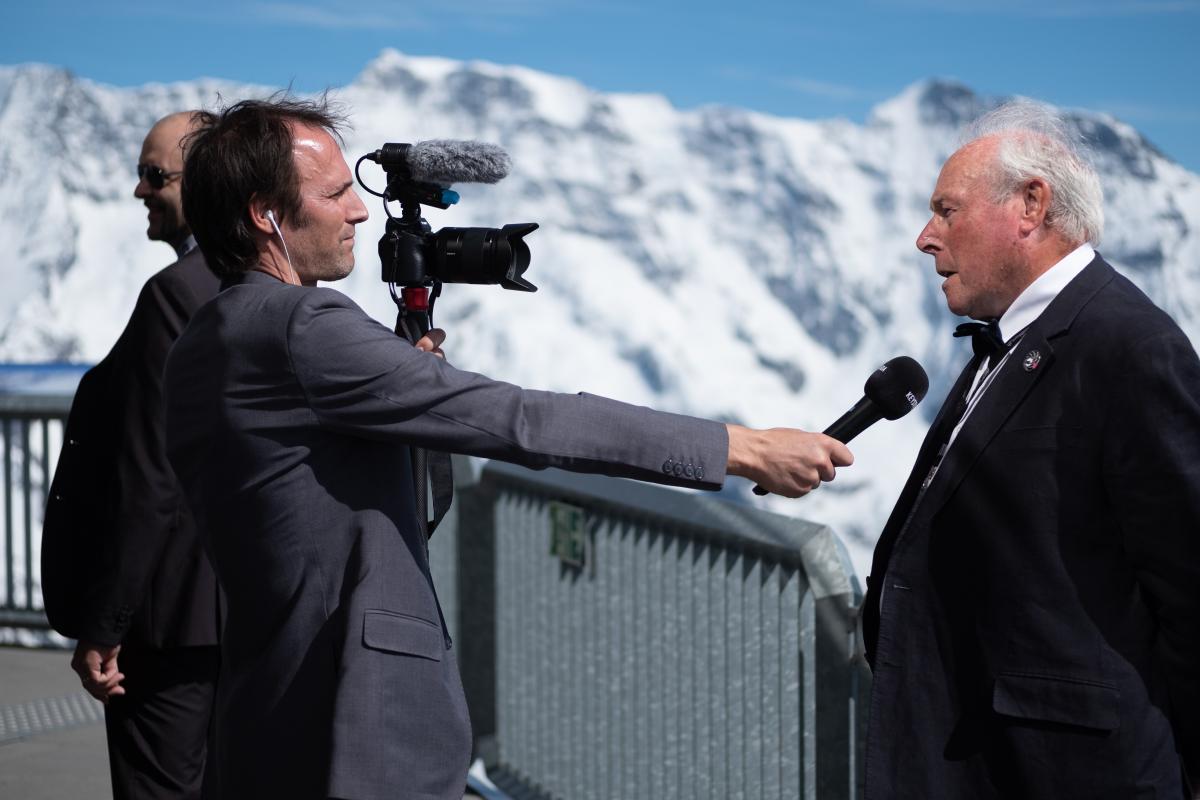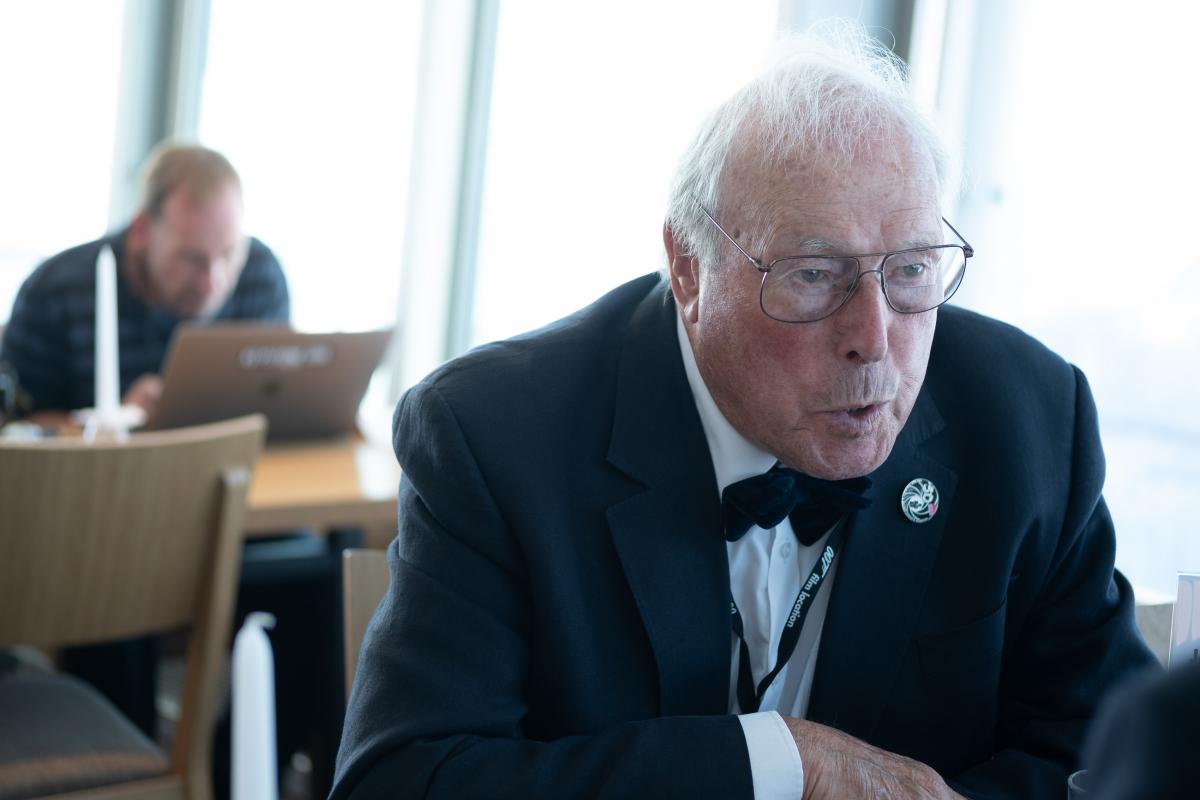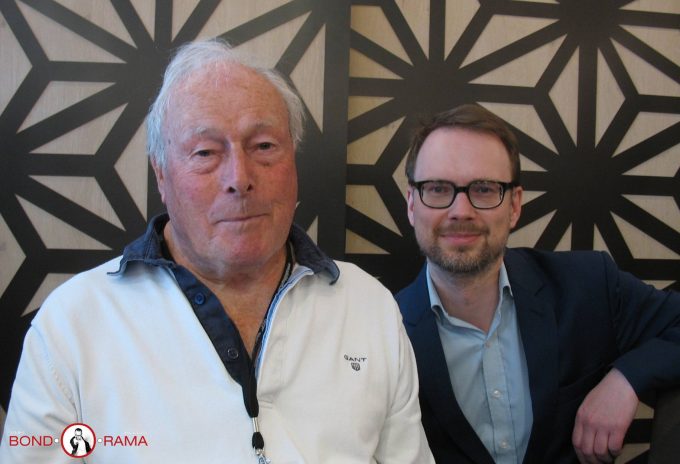During this summer's unofficial OHMSS 50 celebration for "On Her Majesty's Secret Service" at Piz Gloria, James Bond•O•Rama.dk had the pleasure of meeting long-time EON associate John Glen.
The 87-year-old Englishman edited "On Her Majesty's Secret Service" and directed the second unit on location in Switzerland back in 1968-69. John Glen later performed the same duties on "The Spy Who Loved Me" (1977) and "Moonraker" (1979) before graduating to director on every EON-produced Bond film during the 80's: "For Your Eyes Only" (1981), "Octopussy" (1983), "A View to a Kill" (1985), "The Living Daylights" (1987) and "Licence to Kill" (1989).
In this exclusive chat with Bond•O•Rama.dk John Glen discusses some of his favourite Bond locations as well as the editing techniques of "OHMSS" and other tricks of the trade.
● "OHMSS 50": Pictures from Piz Gloria
● "OHMSS 50": Pictures from Mürren, Lauterbrunnen and Bern

John Glen, what would you name as your favourite Bond location?
I think Piz Gloria [would be at number one]. The Bernese Oberland is probably one of the best locations we've ever had. It's such a vast scene, it's very James Bond in its aspects. [The Bond connection] is the history of this place, isn't it.
I believe Piz Gloria and Schilthornbahn is the only Bond film location ever to write in their contract that they had unlimited means of promoting it as an official Bond location. And apparently EON Productions are not very happy about that.
It's indirectly free publicity, it's still 007, isn't it. And that's the important thing. It's an amazing franchise. Everyone says, how long can it go on for. I remember Lewis Gilbert saying to me that he thought it would probably come to an end after "Moonraker", "maybe that's the end of the series". It cost a lot of money, "Moonraker". Subsequently, of course, all of these new markest have opened up.
Udaipur and San Francisco
The other film that I remember very well was India on "Octopussy". We filmed in Udaipur which was a perfect location for us. It was perfect because they had four palaces within a short distance of each other. There was the Winter Palace, the Summer Palace, the Main Palace which was being converted into a hotel where we put all the chief actors, and there was the Lake Palace Hotel which was another palace, Octopussy's palace. And there was also a Winter Palace up on the hill. We used them all. We had to refurbish some of them, you know, just on the facial aspects of the palaces we had to do some repairwork and what have you. But we filmed on Lake Piccolo a lot, and we actually resurrected the love boat which is seen in the film. In, out, in, out, which was a big laugh in the film. So we remade that boat, but it was on an existing plan. And Mike Turk, the boat builder we brought over from England, he actually built that locally, the love boat which we used in the film quite extensively.
Was Udaipur a poor area?
Well, it was quite a rich area compared to a lot of places at that time in India, and I'm sure our film helped to make it even more tourist-friendly. And a lot of friends of mine have been to Udaipur. One of my friends went on a train trip across India, and he was suddenly surprised to hear my voice. And they were running a documentary which included interviews with me shot in Udaipur about the Bond movie there. It was a very happy experience, actually. We had wonderful cooperation. One of the great advantages of that time was, the Indian economy was in such a state that you couldn't remit overseas earnings. All the films, American films that were shown in India, they froze their assets in India. And we managed to do a deal with the Indian government whereby they allowed us to use frozen rupees. So we bought up a lot of frozen rupees at half price which helped our budget enormously, heh-heh.
On the San Francisco film, "A View to a Kill", the Golden Gate Bridge sequence took a lot of thinking about. [You can't go up there] as a tourist but we had very good relationship with the mayor, Dianne Feinstein, she's now a senator. She first asked the question: "How much are you gonna spend in San Francisco", and we said, "Five million dollars". She said, "You can do anything you like!". So she allowed us to go up at the top of the Golden Gate Bridge. There's a two-man escalator that goes up to the twin towers of the bridge. We went up in that, and we would take stuntmen up there and shoot plates of these wonderful vistas up there, you know, when you look down and you see the ropeway, twin lanes of traffic, and underneath that a ship goes through, you know. You get a wonderful sense of depth. And we were able to take VistaVision cameras up there and shoot plates, and at Pinewood we shot three different size bridges, one on the lot - two on the lot, actually, and one on the stage where we shot front projection scenes by lifting a three tonne camera, hanging it above the actors with the screen on the floor. We had to be very careful that all the ropes were secure, because it wouldn't have done them any good if anything had broken loose.

The Moroccan desert
The Living Daylights has very beautiful desert scenery. I believe that was Morocco?
Yeah. "The Living Daylights" was the first of Timothy Dalton's Bonds, it was a good film, and we had a wonderful location in Morocco, wonderful cooperation from the Moroccan government. And also the Air Force, we had the use of a C-130 which we used extensively in the film. Not only to carry our equipment out to the desert but also to film the actual film. We did some remarkable shots there with the horsemen and crossing a bridge which was done with a foreground miniature bridge which married up with a bridge that was ten feet high across the wadi to make it look as though it was a hundred feet high. That was a good technique, it was a technique that we used a lot in those days, we didn't have computerized effects so we had to do it for real, if you like.
It's completely flawless.
Yeah. It's beautiful. There was the horsemen crossing the bridge and then there was the aeroplane bombing the horsemen. The whole thing was so wonderful, and we found that we could actually zoom in across that model with great effect.
Didn't you come across an abandoned film studio out in the desert?
Well, it was a set, it had been used in several films. I think "Lawrence of Arabia" used it as well. It wasn't so much of a film studio, it was just an area that they used for various desert films, and I think "Lawrence of Arabia" came there for quite a few shots. They also went to the south of Spain as well for a few shots, they moved around a lot. But we found Ouarzazate to be quite an interesting place. They were just starting to get a tourism business going there, and there were a couple of decent hotels out in the desert. It was an interesting place because the desert there was submerged under the sea at one time, and you would walk around there, you'd pick up sea shells and things, you know. It's quite amazing. Of course we used a lot of horses there, and it's great for the horses galloping and what have you. We used a lot of Spanish riders, a lot of Spanish stuntmen. I'm trying to think of the name of the Indian actor ...
Art Malik?
Thank you. Art Malik we used, and I said to Art, "Can you ride?", and he said, "Well, a bit". I said, "Okay". So we had Art Malik leading his men, about a hundred horsemen, and charging across. And Art said, "I nearly died. I was in front of these galloping horsemen, they're all expert riders, and I was almost falling off the horse! If I had fallen off, I would have been trampled to death." But he did a good job, we did a couple of takes, and that was enough for him, heh heh!
Editing and sound in OHMSS
I'd like to ask about the editing techniques in "On Her Majesty's Secret Service", especially the fight sequences. The one outside Draco's office was really ahead of its time.
Well, Peter Hunt who was the director of OHMSS, he was an innovative editor. He developed with Terence Young a kind of a strip-cartoon type of editing where you abbreviated the action. He taught me that, actually, that style of editing, and I took over the editing on Majesty's from another editor, so Peter and I both edited on that film. Peter edited some scenes, and I edited the bulk of the film. But his style of editing was very good, and I adapted to it very quickly.
Several of the fight scenes also use sound in a very interesting way. With the fisticuffs echoing around the room and all that.
Yeah. The sound is very important on a Bond film. Slightly exaggerated sound, shall we say. It's like everything you do on a Bond film, it's slightly exaggerated, I mean, bullet hits in the snow wouldn't make a puff of dust, would they. But I used to say, "No, no, you've gotta put explosives in and make every bullet hit look as though it's a nine-inch shell hit in the ground", you know. Things like that, you have to do it, you have to exaggerate it, [otherwise] it doesn't register.
Like the Aston Martin in "OHMSS" that makes a noise skidding in the sand on the beach.
Oh yeah, that's right. One of my favourite tricks in aerial sequences, every time an aeroplane dived I used to put the sound of a Stuka bomber from World War II in, you know. I thought that was a terrifying sound. And it was designed to terrify people, so I was just adapting what happened in Germany.
So you put that sound on no matter what plane was pictured in the frame.
Exactly. It's one of my trademarks. Like the pigeon, someone puts a hand into ... Roger Moore is climbing a rock, and he puts his hand into a handhold, and a pigeon comes out. Of course it frightens the life out of the audience, and it's accompanied by a shrill, not genuine pigeon noise necessarily, but enough to make the audience jump. And that became my trademark. Someone asked me once, "Why pigeons?". And I said, "Because they are available everywhere in the world, and they're cheap!". Ha ha ha.

Swimming with sharks
Talking about animals, I always wondered about the scene in "For Your Eyes Only" where a guy falls into the water and two sharks come up and gobble on him. How did you do that?
Well, sharks, we had a long-standing arrangement in the Bahamas with a cameraman that worked out there with the local people, and they used to catch sharks overnight. And once a shark gets caught into captivity it doesn't become as aggressive, it becomes quite docile, actually. In fact you can almost say that once a shark is caught, it's more or less on its way to be dying, you know. Which is a shame, but it's a fact of life. Somehow they don't recover from it.
Are the sharks set free afterwards?
Well, you use them, you propel them through the shot. You get the divers come in, and they take the shark and they propel it through the shot to get the shot you require. But of course, as far as the audience goes, they are very much alive.
It's one of Kristatos' men falling in, I believe it was George Leech. But it looks like a real man with real sharks.
It was George Leech, yeah. But it wouldn't have been a real shark, it would have been a tin shark. Our clever special effects guys perfected them, really, to make them look very realistic. They are sort of animated, they have motors in them to make them move properly. They did have real sharks there where we shot that in the Corfu channel. The cruise ships threw all of their rubbish into the ocean. Whether they have stopped doing that now, I doubt. But it attracted the sharks, of course. And some of the beaches there had shark nets. As we were filming, I said to the local chap, advisor, "Are there sharks here?" "No no, no sharks here," he said. "But what are those nets for?". He said, "Oh, just to reassure people." Heh heh.
Denmark and Brexit
You visited Copenhagen when you were promoting "A View to a Kill" in 1985.
Yeah. I was very impressed with Denmark. I was very impressed with the precursor to Disneyland, Tivoli Park. I thought that was absolutely beautiful. The weather wasn't the greatest when I was there but you can see where Walt Disney got the idea from. It's very old, I believe, from the 1800's. It's a wonderful thing, it's very good for the public, for the citizens of Copenhagen to go with their children and what have you. There were no scary rides that I remember, it was just a lovely atmosphere, and there were lots of places to eat. Yeah, I was impressed with that. And the Mermaid, I remember. The actual town, it was so clean and people were so nice and friendly. It's quite a small country, isn't it. We tend to eat mostly Danish butter [in the UK], I think. It's a staple. And bacon. So I don't know what's gonna happen when we leave the European Union. I don't think much different will happen, quite honestly. They'll still sell the stuff to us. Otherwise Denmark could come out with the English, they are their best customers, I would imagine! We'll see. It's a shame. Because we were doing quite well. But that's the way it happens. The older people voted out, I think. The younger people didn't bother to vote. Now they wish they had voted. Democracy will prevail, no doubt. [In the recent EU election] they voted against the existing political parties. The protest vote. The green party did well, the Brexit party did extremely well.
Thanks to Schilthornbahn AG for facilitating this interview.

